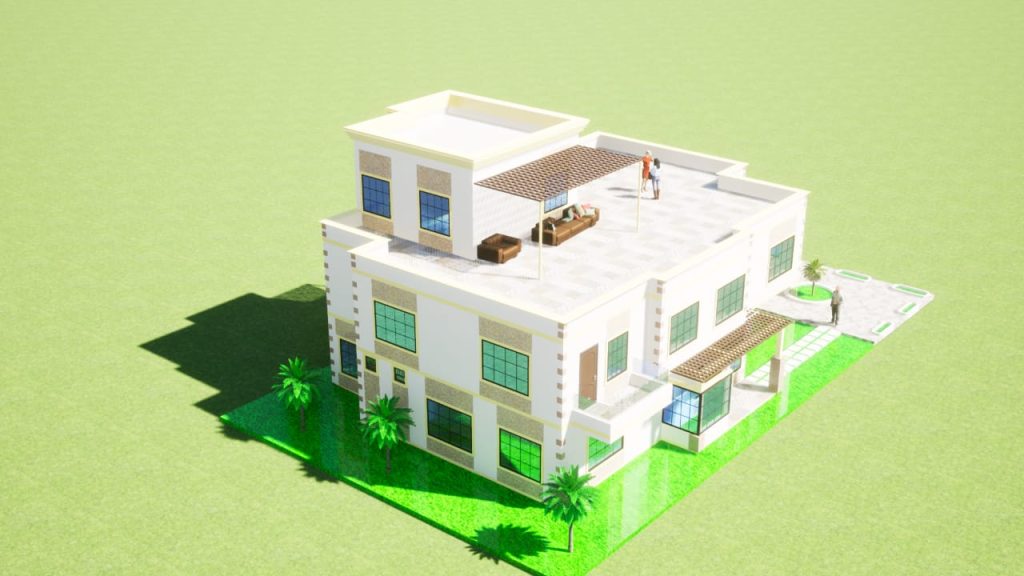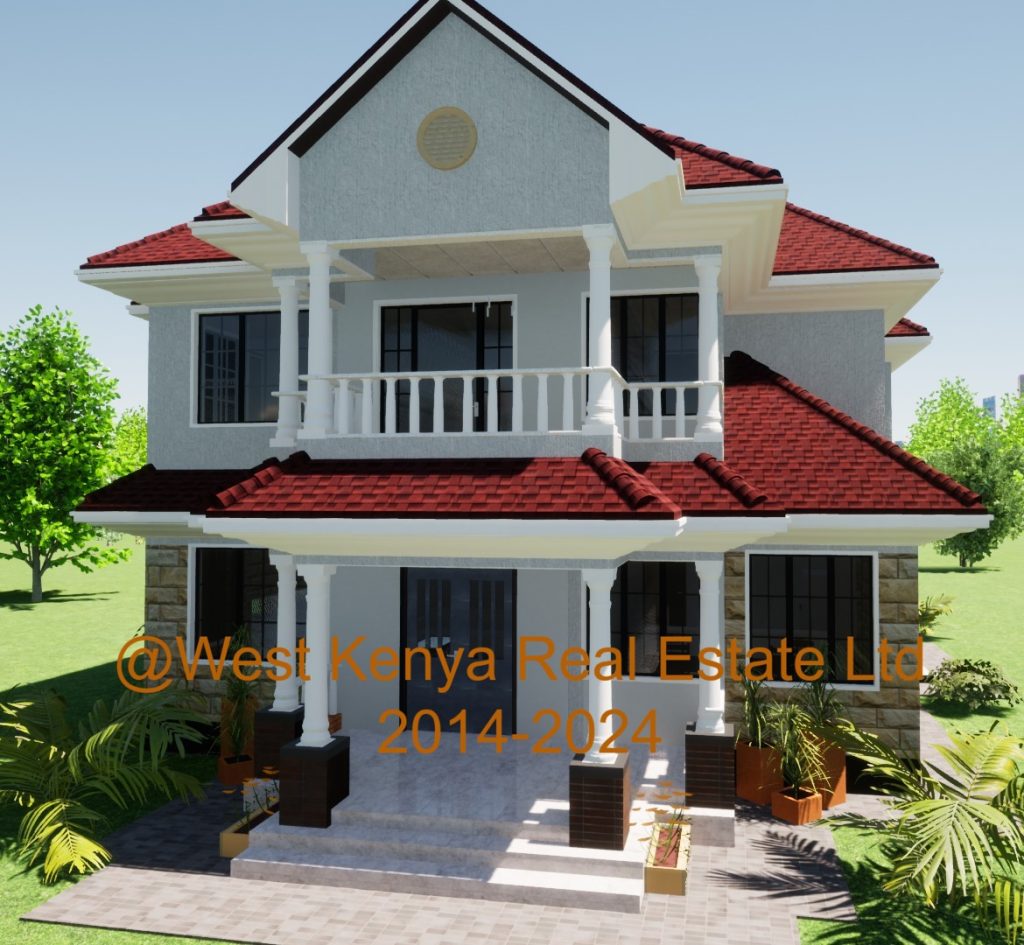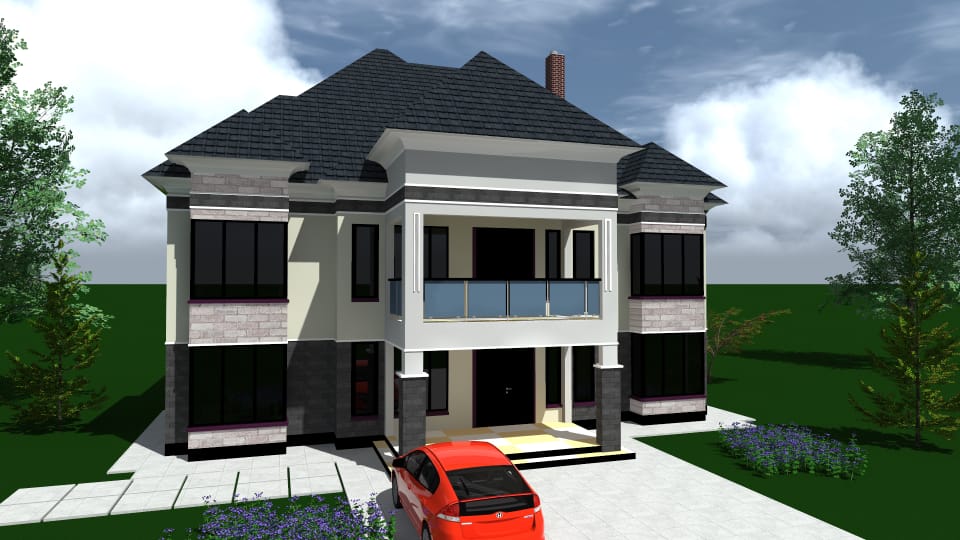FLAT ROOF VS. PITCHED ROOF: CHOOSING THE BEST FOR A 4-BEDROOM HOUSE DESIGN

When designing a four-bedroom house, one of the critical decisions you’ll face is the choice between a flat roof and a pitched roof. Both roof styles offer distinct advantages and challenges, depending on your preferences, climate, budget, and aesthetic vision. This article explores the pros and cons of each roofing option, offering insight into how to choose the best roof for your 4-bedroom house design.
1. Understanding Flat Roofs and Pitched Roofs
Before diving into the comparison, let’s clarify the two types of roofs:
- Flat Roof: As the name suggests, a flat roof is essentially horizontal or has a very slight pitch, typically between 1-10 degrees. This roof style is most commonly used in modern and contemporary home designs.
- Pitched Roof: A pitched roof has a slope, typically ranging from 15 to 45 degrees. It’s a traditional design found in many homes, offering a classic look and practical advantages, such as effective water drainage.
2. Aesthetic Appeal: Which Roof Style Complements a 4-Bedroom House Design?
When selecting the best roof for a four-bedroom house, aesthetics play a crucial role. The roof is one of the most noticeable elements of a home’s exterior, influencing its curb appeal.
Flat Roof: Sleek and Modern
A flat roof can give a 4-bedroom house a sleek, minimalist look. With its clean lines, a flat roof complements modern, industrial, and contemporary home designs. It’s ideal for those who want a home that reflects a modern lifestyle. The simplicity of a flat roof allows other design elements, like large windows or open floor plans, to stand out.

Additionally, flat roofs are often associated with modern architecture because they are used in many high-end luxury homes and commercial buildings.
Pitched Roof: Timeless and Classic
A pitched roof gives a 4-bedroom house a more traditional and timeless appearance. The triangular shape creates a sense of balance and proportion, and it is often found in more rustic or cottage-style homes. A pitched roof can also contribute to the overall character of a home, providing an appealing aesthetic that resonates with many homeowners seeking a classic look.
Many people also associate pitched roofs with warmth and coziness, making them a popular choice for suburban neighborhoods.
3. Functionality: Which Roof Type is More Practical?
When it comes to functionality, each roofing style offers unique advantages depending on your priorities.
Flat Roof: Efficiency and Useable Space
Flat roofs are known for providing extra usable space. With a flat roof, you can create a rooftop garden, patio, or even a deck, offering additional outdoor living space. This feature can be particularly appealing for homeowners in urban areas where space is limited.
Flat roofs also tend to be more efficient in terms of construction costs. They require fewer materials and less labor compared to pitched roofs, making them more budget-friendly, especially for smaller homes or those built on a tight budget.
However, flat roofs require regular maintenance to prevent water accumulation and damage. Without the proper drainage system, standing water can lead to leaks, and over time, the flat roof may need to be replaced.
Pitched Roof: Better Drainage and Durability
Pitched roofs have a natural advantage in terms of water drainage. The slope allows rain and snow to run off easily, reducing the risk of water pooling or leaking. This is especially beneficial in regions with heavy rainfall or snowfall, as it prevents water damage to the roofing material and the structure of the home.
A pitched roof also tends to have a longer lifespan than a flat roof. The materials used in pitched roofs, such as asphalt shingles, clay tiles, or metal roofing, are designed to withstand the elements over time. Additionally, pitched roofs often provide better insulation, contributing to energy efficiency in the home.
However, pitched roofs are typically more expensive to construct than flat roofs, both in terms of materials and labor. This cost difference can be significant when building a 4-bedroom house.
4. Climate Considerations: Choosing the Right Roof for Your Location
Climate is one of the most important factors to consider when deciding between a flat roof and a pitched roof. The roof’s ability to handle local weather conditions can greatly influence your choice.
Flat Roof: Best for Mild Climates
Flat roofs are best suited for mild climates with little to no heavy snowfall or extreme weather. They are common in regions like Southern California, where the weather is dry and warm year-round. In areas with less rain or snow, flat roofs offer a practical, cost-effective option. They are also ideal for places with more consistent weather, where a pitched roof may not be necessary.

Pitched Roof: Ideal for Rain and Snow
If you live in an area with frequent rainfall or snowfall, a pitched roof is generally the better option. The slope helps to ensure that rain and snow don’t accumulate, reducing the risk of leaks or structural damage. In colder climates, the slope helps prevent snow from piling up, which can be a serious issue on a flat roof.
For homes in regions with heavy snow, a pitched roof also reduces the risk of ice dams, which can cause leaks and damage to the roof and home. Pitched roofs are the preferred option in northern states or countries with colder climates, making them ideal for areas with seasonal variations in weather.
5. Cost of Construction and Maintenance
The cost of building and maintaining a 4-bedroom house with either a flat roof or pitched roof can vary significantly.
Flat Roof: Lower Initial Costs, Higher Maintenance
While flat roofs are generally less expensive to construct due to the simpler design, they can require more frequent maintenance. The lack of pitch means that flat roofs are prone to collecting debris, leaves, and water, which can lead to clogged drains and eventual leaks. Over time, the cost of repairing a flat roof may add up, particularly if it requires waterproofing, resealing, or full replacement.
Pitched Roof: Higher Initial Costs, Longer Lifespan
On the other hand, a pitched roof is more expensive to install initially, especially with the added complexity of roof framing, sloping structures, and material choices. However, pitched roofs are more durable and generally require less maintenance over the years. The lifespan of a pitched roof often exceeds that of a flat roof, making it a more cost-effective option in the long term for homeowners looking to invest in the durability and value of their home.

6. Energy Efficiency and Insulation
Both flat and pitched roofs can be designed with energy efficiency in mind, but they each have different ways of contributing to your home’s insulation and overall energy savings.
Flat Roof: Improved Insulation with Proper Design
Modern flat roofs can be equipped with insulation materials that help maintain a consistent temperature inside the home. Some flat roofs are even designed with a green roof system, which adds an extra layer of insulation while also promoting environmental sustainability.
Pitched Roof: Superior Natural Insulation
Pitched roofs, due to their structure, often provide superior natural insulation. The attic space beneath a pitched roof can be used for insulation materials, helping to maintain consistent temperatures in the home. This can result in significant savings on energy bills, especially in extreme climates.
Conclusion: Which Roof is Best for Your 4-Bedroom House?
Choosing between a flat roof and a pitched roof for your 4-bedroom house ultimately depends on your priorities, preferences, and the local climate. If you value modern aesthetics, the potential for additional outdoor living space, and a lower initial construction cost, a flat roof might be the right choice for you. However, if you prefer a traditional look, better water drainage, and long-term durability, a pitched roof may be more suitable.
For homeowners in regions with heavy snowfall or rainfall, pitched roofs are often the better option. However, if you live in a dry or temperate climate, a flat roof may provide the most cost-effective and functional solution.
By considering your location, budget, aesthetic preferences, and practical needs, you can make an informed decision that will ensure your 4-bedroom house design is both beautiful and functional for years to come.
Related post:
How much does it cost to build a one bedroom flat in Kenya?
3 BEDROOM HOUSE PLANS AND COST IN KENYA.
Best 10 House Plans in Kenya and Africa
Must have features in 5br maisonette designs in kenya 2025
How to Build a Residential Apartment Complex in Kenya: Costs and Guide
Best 4-Bedroom House Designs in Kenya: Features and Benefits
4-Bedroom Maisonette House Design in Kenya with DSQ
5-Bedroom Bungalow House Design in Kenya
4-Bedroom Bungalow House Design in Kenya
3-Bedroom Bungalow House Design in Kenya
How Much Does It Cost to Hire An Architect in Kenya For Your Entire Project Design?
How much does it cost to build a 4-bedroom house in Kenya
Cost of building a house in Kenya.
Mansion House Plans in Kenya: A Comprehensive Guide
4 Bedroom Bungalow House Plans in Kenya
Maisonette House Plan-4 Bedrooms
Maisonette House Plan Kenya-4BR Flat Roof
5 Bedroom Maisonette house plans in Kenya
Cost of an Architect to Draw House Plans in Kenya
Secrets of Kenya’s Skyline: Exploring 5-Storey Building Plans in Kenya
Secret Exposed! How much does it cost to build a 4 bedroom house in Kenya?(Updated 2024)
Classic 5 Bedroom Bungalow Building Plans in Kenya WKRE049
4 Bedroom Bungalow House Plans in Kenya